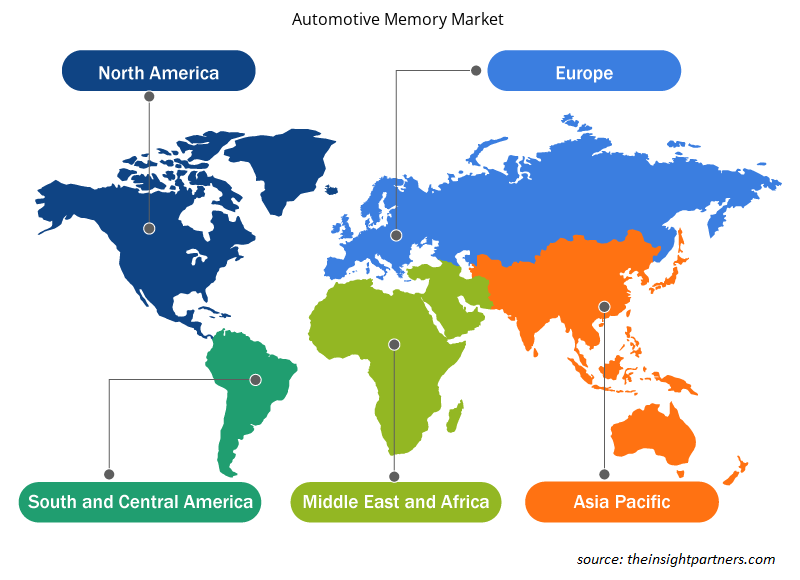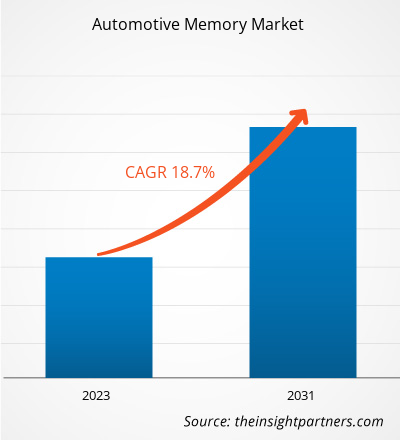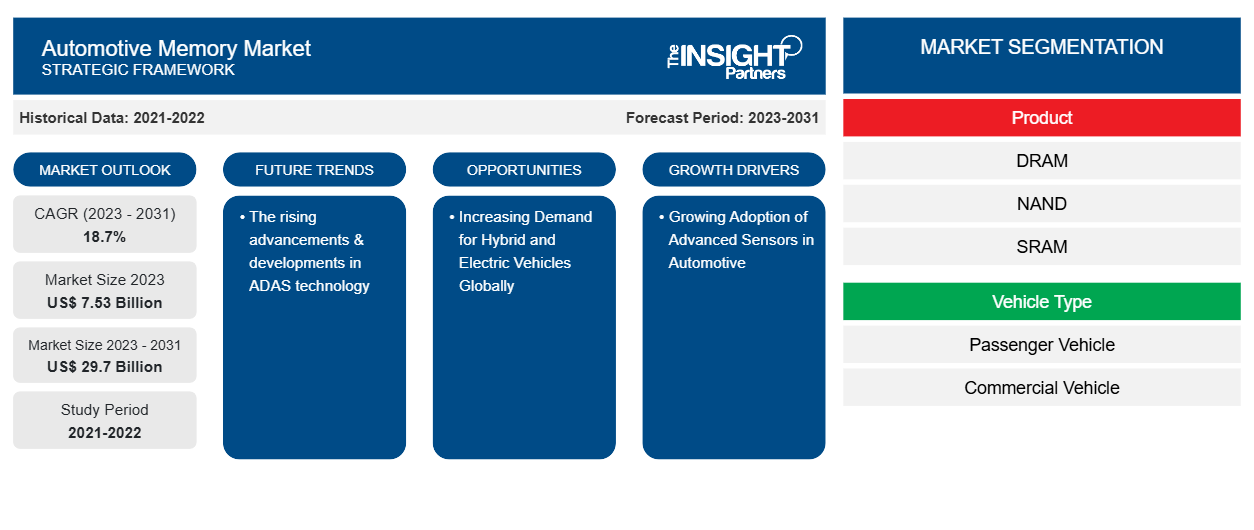자동차 메모리 시장 규모는 2023년 75억 3,000만 달러에서 2031년 297억 달러로 성장할 것으로 예상됩니다. 이 시장은 2023~2031년 동안 18.7%의 CAGR을 기록할 것으로 예상됩니다. ADAS 기술의 발전과 진보는 시장의 주요 트렌드로 남을 가능성이 높습니다.
자동차 메모리 시장 분석
자동차 텔레매틱스 수요 증가와 자동차 애플리케이션에서 센서 채택은 자동차 메모리 수요를 견인할 것으로 예상되며, 이는 향후 몇 년 동안 시장 성장을 촉진할 것으로 예상됩니다. 또한 차량에서 텔레매틱스를 배치하는 것에 대한 엄격한 정부 규정은 2023년부터 2031년까지 시장 성장을 촉진할 것으로 예상됩니다. 게다가 전 세계적으로 하이브리드 전기 자동차와 전기 자동차에 대한 수요가 증가함에 따라 자동차 메모리 수요가 촉진될 것으로 예상되며, 이는 예측 기간 동안 시장의 주요 기업에 기회를 창출할 것으로 예상됩니다.
자동차 메모리 시장 개요
차량은 현재 정적 램, 동적 램, 읽기 전용 메모리 , FLASH, 그리고 어떤 경우에는 자기 저항 램(MRAM)과 같은 다양한 분산 메모리 유형과 통합되어 있습니다. 테스트. 자동차 스토리지는 상업용 스토리지와 기능적으로 유사하지만 다르게 작동합니다. 메모리 액세스 결과에 의존하고 저장된 정보가 올바른 ECC(오류 정정 코드) 메모리와 더 유사합니다. 더 많은 마이크로프로세서가 사용됨에 따라 신호, 정보 처리 및 차량의 기능 간에 정보를 전송하기 위한 SRAM 또는 FLASH 스토리지를 로컬로 담당하는 분산 DRAM이 사용됩니다.
새로운 자동차 아키텍처에는 일반 컴퓨터와 비슷한 거대한 메모리 어레이가 있는 중앙 집중식 기본 중앙 처리 장치(CPU)가 포함됩니다. 이 장치는 모든 운전자 지원, 엔진 및 드라이브 하위 시스템의 데이터를 기반으로 시스템적 결정을 처리하고 내립니다. 수명이 2~5년인 가정용 및 업무용 컴퓨터와 달리 자동차 스토리지는 12~20년 동안 지속적으로 실행해야 합니다.
귀하의 요구 사항에 맞게 이 보고서를 사용자 정의하세요
이 보고서의 일부 또는 국가 수준 분석, Excel 데이터 팩을 포함하여 모든 보고서에 대한 사용자 정의를 무료로 받을 수 있으며 신생 기업 및 대학을 위한 훌륭한 혜택과 할인 혜택을 이용할 수 있습니다.
-
이 보고서의 주요 시장 동향을 알아보세요.이 무료 샘플에는 시장 동향부터 추정 및 예측까지 다양한 데이터 분석이 포함됩니다.
자동차 메모리 시장 동인 및 기회
자동차 시장에서 고급 센서 채택 증가로 시장 선호
자동차 센서는 현대 자동차의 원활한 작동에 필수적입니다. 이러한 센서는 다양한 차량 매개변수에 대한 정보를 전자 제어 장치(ECU)에 제공하여 안전성, 효율성 및 성능을 극대화합니다. 이는 물리적 양을 전기적 임펄스로 변환하여 수행합니다. 이러한 센서는 두 가지 주요 범주로 분류됩니다. 첫째, 측정하는 물리적 특성에 따라, 둘째, 사용하는 기반 기술에 따라 분류됩니다. 이 센서는 마모나 오염으로 인한 오류를 줄이고, 안정적인 측정을 보장하며, 고온 환경에서 공간을 절약하는 데 도움이 됩니다. 압력 센서에 대한 수요가 급증하여 산업이 빠르게 발전할 것으로 예상됩니다. 압력 센서는 자동차의 측면 도어에 설치되어 사고를 방지하기 위해 디지털 충돌 신호를 중앙 에어백 장치로 보냅니다. 따라서 자동차 애플리케이션에서 고급 센서 채택이 증가함에 따라 향후 몇 년 동안 시장 성장이 촉진될 것으로 예상됩니다.
전 세계적으로 하이브리드 및 전기 자동차에 대한 수요 증가
완전 전기 자동차 (EV)와 하이브리드 전기 자동차 의 증가 와 함께 ADAS, 그래픽 계기판(GIC), 인포테인먼트 시스템, 완전 자율 주행 솔루션이 등장하면서 전자 제어 장치(ECU)에 대한 수요가 생겼습니다. ECU는 센서에서 신호를 수신하고 처리하고 액추에이터로 제어 명령을 내보내 실행하는 데 사용되는 자동차 컨트롤러입니다. 예를 들어, 미국에서 2023년에 등록된 신규 전기 자동차는 총 1,400,000대에 달했으며, 2022년에 비해 40% 증가했습니다. 전기 자동차에 대한 이러한 수요 증가는 자동차 메모리 시장에서 활동하는 주요 업체에게 기회를 제공할 것으로 예상됩니다.
자동차 메모리 시장 보고서 세분화 분석
자동차 메모리 시장 분석에 기여한 주요 세그먼트는 제품, 차량 유형 및 응용 프로그램입니다.
- 자동차 메모리 시장은 제품 기준으로 DRAM, NAND, SRAM, NOR 등으로 구분된다. DRAM 부문은 2023년에 가장 큰 시장 점유율을 차지했다.
- 차량 유형별로 시장은 승용차와 상용차로 세분화됩니다. 승용차 부문은 2023년에 시장 점유율이 더 높았습니다.
- 응용 프로그램별로 시장은 인포테인먼트 및 커넥티비티, ADAS 및 기타로 분류됩니다. 기타 세그먼트는 2023년에 시장에서 상당한 점유율을 차지했습니다.
지역별 자동차 메모리 시장 점유율 분석
자동차 메모리 시장 보고서의 지리적 범위는 주로 북미, 아시아 태평양, 유럽, 중동 및 아프리카, 남미 및 중부 아메리카의 5개 지역으로 나뉩니다.
자동차 메모리 시장 보고서의 범위는 북미(미국, 캐나다, 멕시코), 유럽(스페인, 영국, 독일, 프랑스, 이탈리아, 유럽의 나머지 지역), 아시아 태평양(한국, 중국, 인도, 일본, 호주, 아시아 태평양의 나머지 지역), 중동 및 아프리카(남아프리카, 사우디 아라비아, UAE, 중동 및 아프리카의 나머지 지역), 남미(브라질, 아르헨티나, 남미의 나머지 지역)를 포함합니다. 수익 측면에서 아시아 태평양은 2023년 자동차 메모리 시장 점유율을 지배했습니다. 북미는 글로벌 자동차 메모리 시장에 두 번째로 큰 기여를 하고 있으며, 그 다음은 유럽입니다.
자동차 메모리 시장 지역 통찰력
Insight Partners의 분석가들은 예측 기간 동안 자동차 메모리 시장에 영향을 미치는 지역적 추세와 요인을 철저히 설명했습니다. 이 섹션에서는 북미, 유럽, 아시아 태평양, 중동 및 아프리카, 남미 및 중미의 자동차 메모리 시장 세그먼트와 지리에 대해서도 설명합니다.

- 자동차 메모리 시장에 대한 지역별 특정 데이터 얻기
자동차 메모리 시장 보고서 범위
| 보고서 속성 | 세부 |
|---|---|
| 2023년 시장 규모 | 75억 3천만 달러 |
| 2031년까지 시장 규모 | 297억 달러 |
| 글로벌 CAGR (2023-2031) | 18.7% |
| 역사적 데이터 | 2021-2022 |
| 예측 기간 | 2023-2031 |
| 다루는 세그먼트 |
제품별로
|
| 포함된 지역 및 국가 |
북아메리카
|
| 시장 선도 기업 및 주요 회사 프로필 |
|
자동차 메모리 시장 플레이어 밀도: 비즈니스 역학에 미치는 영향 이해
자동차 메모리 시장은 소비자 선호도의 변화, 기술 발전, 제품의 이점에 대한 인식 증가와 같은 요인으로 인해 최종 사용자 수요가 증가함에 따라 빠르게 성장하고 있습니다. 수요가 증가함에 따라 기업은 제품을 확장하고, 소비자의 요구를 충족하기 위해 혁신하고, 새로운 트렌드를 활용하여 시장 성장을 더욱 촉진하고 있습니다.
시장 참여자 밀도는 특정 시장이나 산업 내에서 운영되는 회사나 기업의 분포를 말합니다. 주어진 시장 공간에 얼마나 많은 경쟁자(시장 참여자)가 존재하는지 그 규모나 총 시장 가치에 비해 나타냅니다.
자동차 메모리 시장에서 활동하는 주요 기업은 다음과 같습니다.
- 마이크론 테크놀로지 주식회사
- 삼성전자(주)
- 도시바 주식회사
- 웨스턴 디지털 테크놀로지 주식회사
- SK하이닉스
- 마크로닉스 인터내셔널 주식회사
면책 조항 : 위에 나열된 회사는 어떤 특별한 순서에 따라 순위가 매겨지지 않았습니다.

- 자동차 메모리 시장 주요 업체 개요 알아보기
자동차 메모리 시장 뉴스 및 최근 개발
자동차 메모리 시장은 1차 및 2차 조사 이후의 정성적, 정량적 데이터를 수집하여 평가합니다. 여기에는 중요한 기업 간행물, 협회 데이터 및 데이터베이스가 포함됩니다. 자동차 메모리 시장의 몇 가지 개발 사항은 다음과 같습니다.
- 삼성전자(주)가 세미드라이브와 계약을 체결했다. 이 계약을 통해 삼성전자(주)는 세미드라이브에 자동차용 메모리 솔루션을 공급하게 된다. (출처: 삼성전자(주) 보도자료, 2023년 8월)
- 삼성전자(주)가 새로운 GDDR7 32Gbps DRAM을 개발했습니다. 이 새로운 자동차 메모리 제품은 AI, HPC 및 자동차용 애플리케이션의 기능을 확장할 것입니다. (출처: Club Car, 보도자료, 2023년 3월)
자동차 메모리 시장 보고서 범위 및 제공물
“자동차 메모리 시장 규모 및 예측(2021-2031)” 보고서는 아래 영역을 포괄하는 시장에 대한 자세한 분석을 제공합니다.
- 범위에 포함된 모든 주요 시장 세그먼트에 대한 글로벌, 지역 및 국가 수준의 자동차 메모리 시장 규모 및 예측
- 자동차 메모리 시장 동향 및 드라이버, 제약, 주요 기회와 같은 시장 역학
- 자세한 PEST 및 SWOT 분석
- 주요 시장 동향, 글로벌 및 지역 프레임워크, 주요 업체, 규정 및 최근 시장 개발 사항을 포괄하는 자동차 메모리 시장 분석
- 시장 집중도, 히트맵 분석, 유명 업체 및 자동차 메모리 시장의 최근 개발 사항을 다루는 산업 환경 및 경쟁 분석
- 자세한 회사 프로필
- 과거 분석(2년), 기준 연도, CAGR을 포함한 예측(7년)
- PEST 및 SWOT 분석
- 시장 규모 가치/거래량 - 글로벌, 지역, 국가
- 산업 및 경쟁 환경
- Excel 데이터세트
최근 보고서
사용 후기
구매 이유
- 정보에 기반한 의사 결정
- 시장 역학 이해
- 경쟁 분석
- 고객 인사이트
- 시장 예측
- 위험 완화
- 전략 기획
- 투자 타당성 분석
- 신흥 시장 파악
- 마케팅 전략 강화
- 운영 효율성 향상
- 규제 동향에 발맞춰 대응























 무료 샘플 받기 - 자동차 메모리 시장
무료 샘플 받기 - 자동차 메모리 시장